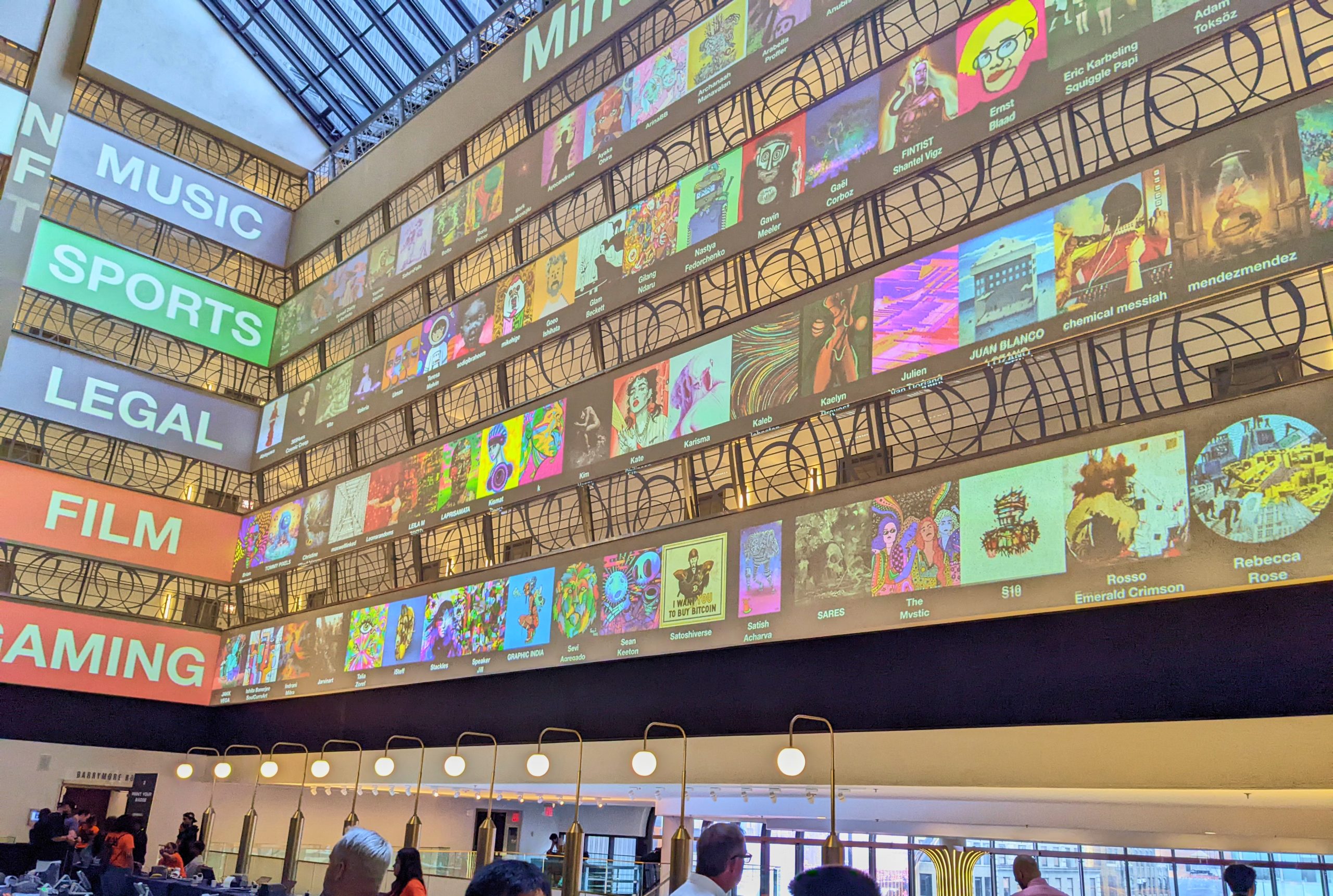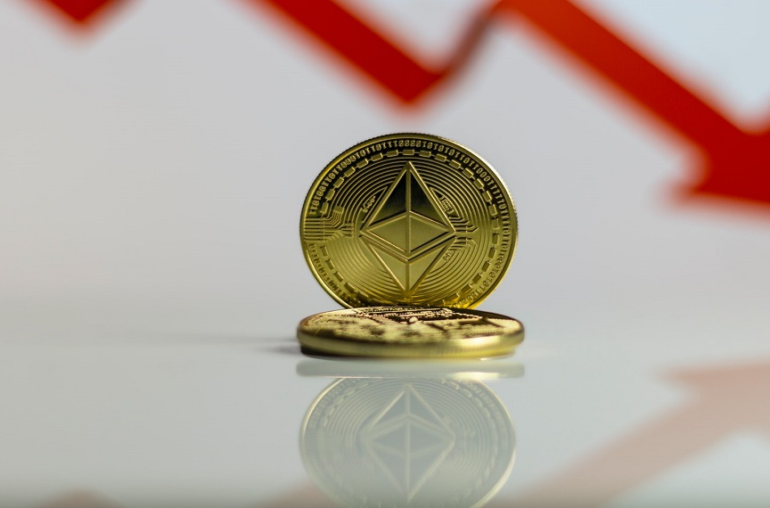Hyperallergic
Sensitive to Art & its Discontents
With a fresh Ethereum wallet ready to scoop up freebies, I attended NFT.NYC 2022, the world’s largest conference dedicated to that controversial wart on the Zeitgeist, the “non-fungible token.” Like other observers, I quickly discovered that, despite dramatic declines in prices of many NFTs and cryptocurrencies, the tone of the conference remained jubilant, as attendees and vendors seemed excited to help “build” what they see as a disruptive, new technology.
The topical mantra in every corner of the multiple Midtown venues was that to succeed and survive, NFT collections will need to develop additional “utility.”
What many outside commenters fail to appreciate is that NFTs have become much more than “overpriced JPGs,” but now function more as bets, arguably in the form of unlicensed securities, on the future success of new online brands. In essence, they are speculation on the durability and profitability of financially-liquid stakes in apes, wizards, and goblins.
And as with memes, the digital images on their own, with some exceptions, are inclined to have a short shelf life. In the contemporary art market, artists carefully manage their careers to give their work sustained, long-term value. In the NFT market, a world heavily influenced by art world professionals, the tradability of the tokens grants a number of new tricks for constructing sustained value and revenue streams to add to the classic ones.
Although conspicuous consumption of the hottest brand is surely another explanation, the main reason that a “Bored Ape” costs the price of a house is not because of the aesthetic merit of an individual image, but because holders expect that future value from the Bored Ape brand will rebound back to them through financial, reputational, and social means.
For example, holders of any of the 10,000 “profile pictures” might receive additional demand or revenue after the launch of a newly-linked videogame, film, toy line, or metaverse project (which constitute the most commonly-promised forms of “utility”). They might also gain privileged access to a new currency linked to the NFTs (Bored Ape holders, for example, were gifted thousands of dollars of a new cryptocurrency token called $APE or “Apecoin”).
Yet, without the protections of traditional securities law, NFT holders and NFT project administrators are entrenched in constant informal negotiations about next steps in project “roadmaps” to bring more utility and value to the holders. These discussions typically take place crassly on Twitter or, more intimately, in the moderated Discord channels of each individual NFT project. If the project directors, who financed the art’s creation and the marketing for the project’s launch (or “minting”), ever get exhausted and don’t see the collection as sufficiently lucrative to maintain, they might sell off the NFTs they own and move on. This is called “pulling the rug,” and it sometimes comes quite early in a project’s life cycle.
A collector with the handle “Atlanta Coffee Shops,” or Eugene, whom I met at a special “holders-owner” breakfast for the Meta Angels NFT collection, told me that he was fully prepared to see many of his NFT collections go to zero. Nevertheless, he still felt confident that a few of the best brands would survive.
As I met the organizers of several major NFT projects in this rooftop lounge in Nomad, I asked them what was their real incentive to continue to build new utility, especially if they had already “minted” the collection and seen much of the revenue that they personally would get. (The founders typically do continue to receive royalty revenue from sales, and in theory, they can extract value from the portion of NFTs they set aside for themselves). There may always be a temptation to bring any utility to a newly-minted NFT project that would bring new capital.
Daniel Horvath of the project “Republic of Hamsters” told me that he feels a moral obligation to produce additional value for holders, and pledged that he would never abandon them and move on to a different collection. His NFT brand is pursuing an array of offerings, including “artworks, games, cartoons, and films.” While I was taken by his earnestness and firm determination, after seeing dozens of NFTs promise the exact same things throughout the conference, I wondered if the market could really sustain so many (typically animal-themed) videogames, and questioned how easy it would be for NFT entrepreneurs to transition to gaming, a notoriously challenging industry.
Perhaps more sanguine about the challenges, Allyson Downey of Meta Angels told me that she doesn’t feel the need to promise an array of new utility offerings. Instead, she sees the value of holding the NFT more in terms of the online community it provides access to, pointing to the intangible value of the coaching and life support that the brand had fostered.
The Meta Angels breakfast, with its mimosas, croissants, and tasteful pins, tailored to a prim and yuppie crowd. More common throughout the conference week were dozens of raucous nighttime parties held throughout Manhattan and Brooklyn. Given that many of the 1,500 talks at the conference took place in sparsely-attended conference rooms, it became obvious that the parties were the real draw to New York.
I had my eye on a concert with Madonna sponsored by the World of Women NFT project, for which I had sniped a $600 World of Women Galaxy NFT in anticipation. Yet, with minimal guidance from the collection ahead of time, I learned that I was out of luck, having failed to successfully complete a bug-ridden form within two or three minutes of it going live at 9am. Soon I was looking at a Discord chatroom of other frustrated holders who had spent thousands of dollars on flights, hotels, and expensive conference tickets, yet were sinking into the realization that their wildly expensive NFTs didn’t give them the “utility” to attend even one event related to their favorite NFT project, neither the “rooftop party” nor the Madonna concert.
My disappointment with World of Women, and that of others, illustrated the dilemma that NFT collections face in their quest for “utility.” No matter how much money an original NFT minting brings in, it will remain a never-ending challenge to both please existing holders and shift capital to new offerings. So long as popular NFTs function as unlicensed securities, with the entitlements of holders ill-defined, this tension will characterize the NFT space.
A childhood accident took her arms away but the transgender artist survived to create paintings, photography, and performances focused on depicting the body.
Fans of director Claire Denis should check the film out, but as an agnostic, I find it one of her few truly awful pictures.
International audiences have free access to the media collections of MMCA Korea, Sharjah Art Foundation, and ArkDes through this subscription-based art streaming platform.
There are 30 nations represented in the international exhibition. Some aren’t in their best moment today. A comics diary.
Some have compared her album art to John Collier’s 19th-century portrait of Lady Godiva, but Beyoncé can channel her radical spirit without evoking Western art history.
Convened by Erika Sprey, Lamin Fofana, Sky Hopinka, Emmy Catedral, and Manuela Moscoso, the public program unfolds this summer at CARA in New York City.
Hundreds of copies of the LA-based guerrilla poster artist Robbie Conal’s latest work, “Supreme Injustices,” were pasted up from Venice to Los Feliz.
This week, another reason to leave Facebook, who really invented democracy, and what is “Skimpflation”?
The Bay Area art book fair is back this July with free programming at three different on-site venues, new exhibitors, and fundraising editions from renowned artists.
Your list of must-see, fun, insightful, and very Los Angeles art events this month, including Pope.L, Beatriz Cortez, Mika Rottenberg, and more.
The acclaimed composer and noise artist talks to Hyperallergic about his Pulitzer Prize-winning composition “Voiceless Mass.”
Her works, depicting objects from Korean markets, invite viewers to marvel at what can be achieved with fabric.
Todd Fine is a PhD candidate in history at the CUNY-Graduate Center. He is President of the Washington Street Advocacy Group, which does creative advocacy related to public history. More by Todd Fine
Your email address will not be published.
{{#message}}{{{message}}}{{/message}}{{^message}}Your submission failed. The server responded with {{status_text}} (code {{status_code}}). Please contact the developer of this form processor to improve this message. Learn More{{/message}}
{{#message}}{{{message}}}{{/message}}{{^message}}It appears your submission was successful. Even though the server responded OK, it is possible the submission was not processed. Please contact the developer of this form processor to improve this message. Learn More{{/message}}
Submitting…
Hyperallergic is a forum for serious, playful, and radical thinking about art in the world today. Founded in 2009, Hyperallergic is headquartered in Brooklyn, New York.


